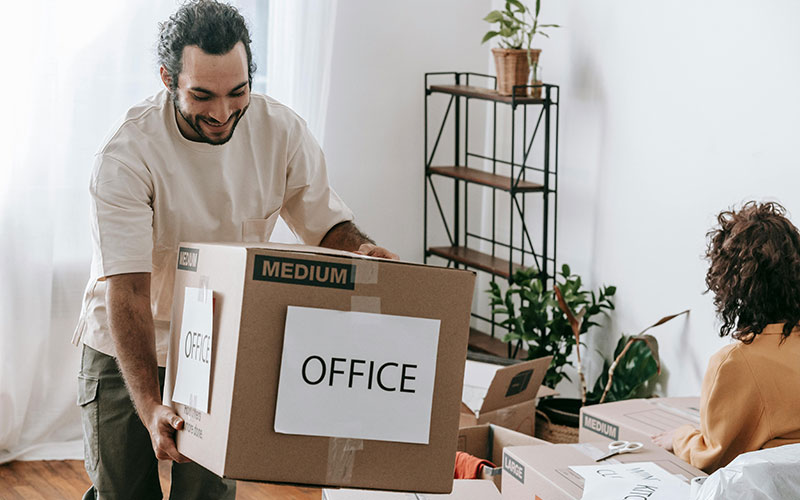I will be upfront with you, moving your home office can be tricky and complex. It requires proper efficiency and organization to pull off.
Whether you are moving to a new location or simply trying to upgrade your workspace, you need to be proactive with your planning to ensure a successful move.
So, what can you do to achieve a smooth and stress-free transition?
Create a Detailed Checklist
As outlined earlier, pulling off a successful move requires proper planning and organization. This starts with a checklist.
A checklist prioritizes all the items you plan to move. Having this document readily available will help in smoothening the whole packing process.
Of course, the items in your home office have varied significance. This is where you need to set clear priorities. What would you be needing immediately after you arrive at your new location? Which document and work equipment do you need to keep accessible? What do you need to let go of?
These are all important questions that will guide you in making the best of your packing and moving process. Trust me when I say you’ll be saving yourself a lot of time and energy.
So, relax, think, list, reflect, erase, and list again. But the important thing to bear in mind as you prepare your checklist is priority.
Backup Your Digital Files
This is a no-brainer. It is easy to lose important files amid relocation. This is why you must secure your files by backing them up.
You should back them up in more than one location. First, in an external hard drive and secondly, with a cloud storage solution.
An external hard drive offers a critical layer of protection by allowing you to create a physical backup of your essential files. You can access this backup during emergencies, Ensure the external hard drive you purchase is of a high quality and has enough storage capacity. It is also recommended that you use a backup software you can rely on to synchronize your files with the external hard drive regularly and automatically.
The second location to back up your files is in the cloud, i.e., remotely. Cloud storage solutions offer a reliable and convenient way to store and protect your important files.
There are numerous cloud storage providers you can use. Some of them include Microsoft OneDrive, Google Drive, and Dropbox. With these cloud solutions, you can store your files remotely and access them from any device whenever you need them.
This robust approach to protecting your important data means you can rest assured that your files are protected during your home office relocation.
Properly Package Your Electronic Devices
It is also important to package your electronic devices properly to protect them from damage during the move. If you still have the original packaging, it would be a smart decision to work with it.
Apart from shielding the screens and delicate parts of your devices from damage caused by bumps during transportation, these original packs would also protect them from environmental damage since they were designed to control humidity.
If you cannot locate the original packaging, you may need to consider anti-static bags as an alternative.
Generally, here are some tips to bear in mind while packing your electronic devices:
- Ensure you disconnect any cables and accessories
- Take your time to properly wrap each device in bubble wrap or packing paper
- Place the wrapped devices in a box. Very importantly, make sure there is enough padding around them. This limits shifting in the case of jolts and bumps during transportation.
- Finally, seal the box with packing tape. Then you can label it as fragile so your movers can handle it carefully.
Talking about labelling…
Label Your Boxes
You already have an idea why labelling your boxes is critical. It helps your movers know what is inside each box and how to handle them.
But apart from that, labelling your boxes is also useful to you. How? It helps you unpack faster when you arrive at your new office. It also ensures you can easily access your essential items during the move since you know exactly where they are.
Here are helpful tips to help you label effectively:
- Use a consistent system, such as color-coded labels to categorize items.
- Indicate fragile items.
- Ensure clarity in your labelling by listing the contents of each box.
- Add a specific label to boxes that contain vital items like your computer or essential documents. This is important for easy accessibility upon arrival.
Take Care of the Utilities Before You Arrive
Another smart decision is to set up essential utilities like internet and phone lines in advance when moving your home office. This will help you integrate properly into your new environment and productively pick up from where you left off.
Dealing with Internet downtime can be pretty frustrating, especially if you need to stay connected with colleagues and clients. However, ensuring your core infrastructures are in place gives you much-needed assurance.
Managing Work During a Move
It may be difficult to manage work during a home office move. But following these tips below will help you reduce disruption and ensure a seamless transition:
- Plan your work schedule to accommodate the moving tasks.
- Be realistic in setting deadlines. Establish project priorities so that important tasks are completed well on time.
- Inform your clients and colleagues about your move and communicate any potential delays in advance.
- If you are unable to work, outsource or delegate some tasks to lessen your workload.
Bottom line
Despite what the first paragraph said about home office relocation being tricky and complex, it is very easy to navigate if you prepare properly.
You don’t necessarily have to disrupt your productivity because of your home office move. These valuable tips outlined in this article will help in streamlining the process, ensuring your transition is smooth and efficient













